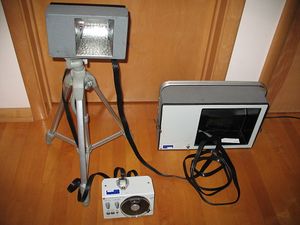Stroboscopics: Difference between revisions
mNo edit summary |
mNo edit summary |
||
| (One intermediate revision by the same user not shown) | |||
| Line 3: | Line 3: | ||
=== Mechanism of Action === | === Mechanism of Action === | ||
[[File:Stroboscope by General Radio Corporation - separate control box and strobe on tripod.jpg|alt=Stroboscope|thumb|'''Figure 1'''. A Stroboscope]] | [[File:Stroboscope by General Radio Corporation - separate control box and strobe on tripod.jpg|alt=Stroboscope|thumb|'''Figure 1'''. A Stroboscope]] | ||
The light emitted by the stroboscope (See '''Figure 1.''') | The light emitted by the stroboscope (See '''Figure 1.''') flashes at the same frequency as the transmission rate of the optical nerve. This causes an temporary interference pattern which disorientates optical transmission to the brain leading to visual [[hallucinations]] similar to effects induced by [[Psychedelics|psychedelic]] substances. | ||
Stroboscopics lights can be calibrated to different frequencies, inducing a variety of effects including: | |||
* '''8 to 11 Hz''' - low level hallucinations | |||
* '''19 to 25 Hz''' - medium level hallucinations<ref>'''''The hodology of hallucinations'''. FFYTCHE, D. (2008). Cortex, 44(8), 1067–1083.'' doi:10.1016/j.cortex.2008.04.005. Accessed on 17th September 2022 via: https://pubmed.ncbi.nlm.nih.gov/18586234/</ref> | |||
* '''40 Hz''' - standard therapeutic frequency, shown to improve aspects of visuomotor and cognitive performance in healthy populations, including short-term memory, attention, visual response times<ref>'''Study on the effect of 40 Hz non-invasive light therapy system'''. A protocol for a randomized, double-blinded, placebo-controlled clinical trial. Front. Aging Neurosci., 12 October 2023 Sec. Alzheimer's Disease and Related Dementias. Volume 15 - 2023 | <nowiki>https://doi.org/10.3389/fnagi.2023.1250626</nowiki> Accessed on 27 Jun 2024 via: <nowiki>https://www.frontiersin.org/journals/aging-neuroscience/articles/10.3389/fnagi.2023.1250626/full</nowiki></ref><ref>'''Short- and Long-Term Stroboscopic Training Effects on Visuomotor Performance in Elite Youth Sports'''. Part 2: Brain-Behavior Mechanisms. Hülsdünker, T., Gunasekara, N., & Mierau, A. (2020). ''Journal is not defined within the JOURNAL database.''. <nowiki>https://doi.org/10.1249/MSS.0000000000002543</nowiki>.</ref><ref>'''Stroboscopic visual training: The potential for clinical application in neurological populations.''' Das, J., Walker, R., Barry, G., Vitório, R., Stuart, S., & Morris, R. (2023). ''PLOS Digital Health'', 2. https://doi.org/10.1371/journal.pdig.0000335.</ref>, and decrease drowsiness and increase cortical arousal<ref>'''The effect of stroboscopic effect on human health indicators.''' Zhao, X., Hou, D., Lin, Y., & Xu, W. (2020). Lighting Research & Technology, 52, 389 - 406. <nowiki>https://doi.org/10.1177/1477153519871688</nowiki>.</ref>. | |||
* '''60 Hz''' - in some studies has been compared to the effects of [[ketamine]], enabling mature perineuronal nets disassembly in the brain<ref>'''Microglia enable mature perineuronal nets disassembly upon anesthetic ketamine exposure or 60-Hz light entrainment in the healthy brain'''. Venturino A, Schulz R, De Jesús-Cortés H, et al. Cell Reports. 2021 Jul;36(1):109313. DOI: 10.1016/j.celrep.2021.109313. PMID: 34233180; PMCID: PMC8284881.</ref> | |||
Whilst the visual aspects of the [[Psychedelics|psychedelic]] experience can be replicated, there is no evidence to suggest any other neurological effect occurs. The effects of stroboscopics can be readily demonstrated via [[Experiments|experiment]] or from the comfort of one's home using [https://burnzero.com/Setting#:~:text=an%20individual%20basis.-,Psychedelic,-Visualisation%20Modulators Psychedelic Visualisation Modulators], the strongest of which is the [https://strobe.cool/ stroboscopic] tool. | Whilst the visual aspects of the [[Psychedelics|psychedelic]] experience can be replicated, there is no evidence to suggest any other neurological effect occurs. The effects of stroboscopics can be readily demonstrated via [[Experiments|experiment]] or from the comfort of one's home using [https://burnzero.com/Setting#:~:text=an%20individual%20basis.-,Psychedelic,-Visualisation%20Modulators Psychedelic Visualisation Modulators], the strongest of which is the [https://strobe.cool/ stroboscopic] tool. | ||
'''References''' | '''References''' | ||
Latest revision as of 01:33, 27 June 2024
Stroboscopics is a technique that uses a bright flashing light to induce visual hallucinations. The technique works by confusing optic nerve transmission which results in perceptual changes.
Mechanism of Action
The light emitted by the stroboscope (See Figure 1.) flashes at the same frequency as the transmission rate of the optical nerve. This causes an temporary interference pattern which disorientates optical transmission to the brain leading to visual hallucinations similar to effects induced by psychedelic substances.
Stroboscopics lights can be calibrated to different frequencies, inducing a variety of effects including:
- 8 to 11 Hz - low level hallucinations
- 19 to 25 Hz - medium level hallucinations[1]
- 40 Hz - standard therapeutic frequency, shown to improve aspects of visuomotor and cognitive performance in healthy populations, including short-term memory, attention, visual response times[2][3][4], and decrease drowsiness and increase cortical arousal[5].
- 60 Hz - in some studies has been compared to the effects of ketamine, enabling mature perineuronal nets disassembly in the brain[6]
Whilst the visual aspects of the psychedelic experience can be replicated, there is no evidence to suggest any other neurological effect occurs. The effects of stroboscopics can be readily demonstrated via experiment or from the comfort of one's home using Psychedelic Visualisation Modulators, the strongest of which is the stroboscopic tool.
References
- ↑ The hodology of hallucinations. FFYTCHE, D. (2008). Cortex, 44(8), 1067–1083. doi:10.1016/j.cortex.2008.04.005. Accessed on 17th September 2022 via: https://pubmed.ncbi.nlm.nih.gov/18586234/
- ↑ Study on the effect of 40 Hz non-invasive light therapy system. A protocol for a randomized, double-blinded, placebo-controlled clinical trial. Front. Aging Neurosci., 12 October 2023 Sec. Alzheimer's Disease and Related Dementias. Volume 15 - 2023 | https://doi.org/10.3389/fnagi.2023.1250626 Accessed on 27 Jun 2024 via: https://www.frontiersin.org/journals/aging-neuroscience/articles/10.3389/fnagi.2023.1250626/full
- ↑ Short- and Long-Term Stroboscopic Training Effects on Visuomotor Performance in Elite Youth Sports. Part 2: Brain-Behavior Mechanisms. Hülsdünker, T., Gunasekara, N., & Mierau, A. (2020). Journal is not defined within the JOURNAL database.. https://doi.org/10.1249/MSS.0000000000002543.
- ↑ Stroboscopic visual training: The potential for clinical application in neurological populations. Das, J., Walker, R., Barry, G., Vitório, R., Stuart, S., & Morris, R. (2023). PLOS Digital Health, 2. https://doi.org/10.1371/journal.pdig.0000335.
- ↑ The effect of stroboscopic effect on human health indicators. Zhao, X., Hou, D., Lin, Y., & Xu, W. (2020). Lighting Research & Technology, 52, 389 - 406. https://doi.org/10.1177/1477153519871688.
- ↑ Microglia enable mature perineuronal nets disassembly upon anesthetic ketamine exposure or 60-Hz light entrainment in the healthy brain. Venturino A, Schulz R, De Jesús-Cortés H, et al. Cell Reports. 2021 Jul;36(1):109313. DOI: 10.1016/j.celrep.2021.109313. PMID: 34233180; PMCID: PMC8284881.
